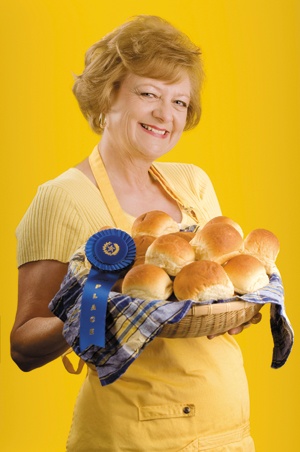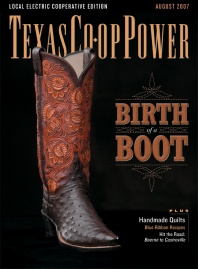The county fair is a showcase, and sometimes showdown, for home cooks, who nervously pit their loftiest meringue pies and tastiest jams and jellies against their neighbors’ year after year. To earn one of the coveted blue ribbons, you need not only a sure-fire recipe and great technique but also a knack for eye-catching presentation. Here are some tips, plus two award-winning recipes, from Texas Certified Home Economist Linda Sanderson Moore, who has garnered a basketful of prizes and spent 12 years as a fair judge.
Think Like a Judge
Judges are selected because they have some type of specialized culinary training. Each category requires a minimum of two judges and often three judges. What one judge might miss, another will surely catch.
Remember that people judge with their eyes first. A fluffy white cake with a cloud of coconut may have our mouths watering before the first bite. Judges are no different. Go all out. Present your entry as if it were being photographed for a food magazine.
Choosing a Recipe
First, decide what recipe you want to use. Select a recipe you have used many times before, that you have had compliments on and would take somewhere to share with others. Don’t use Aunt Betty’s cake recipe if your only experience with it has been eating it.
Check the fair book to make sure the recipe you have chosen fits into one of the categories set by fair officials. Read and follow all fair guidelines carefully.
Ingredients and Cooking Tips
Always use quality ingredients! Even if the recipe calls for margarine, use butter instead. An experienced judge can tell.
If using eggs, break them one at a time into a separate bowl. Examine each egg before adding it to the other ingredients. Discard eggs with a blood spot and always remove the “curly white stem” that is connected to the egg yolk (when it is subjected to heat, it can become gristly). Do not use jumbo eggs in your recipes unless specified.
When your recipe calls for nuts, be generous. In most cases, use nut halves or large pieces. If your recipe has nuts sprinkled on the top or will be rolled in nuts, toast the nuts first. A lightly toasted nut will enhance the flavor greatly.
Never grease and flour the sides of your baking pan; only do so on the bottom. As the product rises in the pan, the dough will slide down the sides of a greased pan, causing a “rolled effect,” and then pull away from the sides, often causing a space between the dough and the pan itself. On untreated sides, the dough will cling to the sides of the pan and allow a more even surface on the top. Bread is the exception to this rule but grease the sides very lightly. Also, don’t overgrease your pan. An overgreased pan will not only cause your crust to be too brown but also will make the crust tough. Lightly brush the top of your loaf and rolls with butter before placing them in the oven. Bread with a powdered flour top is less appealing than that with a shiny, buttered top.
When you are baking a chocolate item and your recipe calls for a greased and floured pan, substitute cocoa for flour. Flour looks unattractive on the bottom of a chocolate product, but cocoa will not. As a judge, I often turn over a brownie or piece of cake to examine the bottom.
Always use the correct measuring cups. Measure dry ingredients in a standard dry measuring cup (without a spout). Measure liquid ingredients in a standard liquid measuring cup (with a spout). Be precise in your measurements. Level dry measurements with a straightedge and be certain the entire amount has been emptied from the cup when adding it to other ingredients. When measuring a liquid ingredient, get down to eye level with the mark to make sure you have the exact amount.
Make certain your oven is calibrated accurately. Many ovens are as much as 25 degrees off. An appliance technician can check and calibrate your oven. Most hardware stores sell temperature gauges for ovens, if you want to check it yourself.
Check the recipe’s cooking time carefully. If the recipe calls for an 18 to 20 minute baking period, be watchful at 14 minutes. Overcooking will certainly cost you a ribbon.
Browning bread or rolls is critical. The year I won my blue ribbon for yeast rolls, I literally pulled a chair up to the oven window and watched the browning process. Although my family would never turn down a dark-topped roll at my table, dark brown is too close to burnt from a judge’s viewpoint.
On the Day of the Fair
When you show up at the fair, think of yourself as already being a winner! Arrive dressed like a winner. If you come clean and well-groomed, you’ll feel better—and you’ll be ready when it’s time to take winners’ photos.
Don’t fall for the misconception that if the product is still warm from the oven the judges will pick it. Not so! Baked products need time to “stand” and become firm. Warm cakes are usually crumbly and have no body. Warm cakes do not support icing well, either.
When cutting your product to enter, cut a generous serving. Cut the pieces so they are all uniform and exact in size. Never enter a corner piece. Pick big cookies and big pieces of candy as close to the same size as possible.
Once your product has been entered—leave. When all of the judging is over, go back to see how you did. Don’t be disappointed with a third-place ribbon or even an honorable mention! These awards often pushed me into thinking about next year’s plans.
Be sure to take your fair book with you to view the entries. Make notes of the categories that do not have many entries and consider entering that category next year. Make notes about special effects or garnishes that you like and about the winners in the categories you entered.
You won’t get rich off the winnings from the fair, but the odds are better than the Texas Lottery! Start feeling lucky, get out the recipes and get organized!
Yeast Rolls
2 cups lukewarm water
1 package dry yeast
1 teaspoon salt
1 egg
6 tablespoons sugar
3 tablespoons melted butter
6 cups flour
Combine all ingredients in large mixing bowl. Let dough rise 1 hour or until double in size. Punch down. Form into rolls and let them rise for 1 hour in a lightly greased pan.
Preheat oven to 450 degrees. Brush tops of rolls lightly with melted butter and bake for 10–15 minutes. Makes 3 dozen rolls.
Serving size: 1 roll. Per serving: 95 calories, 2 g protein, 1 g fat, 18 g carbohydrates, 71 mg sodium, 8 mg cholesterol
Un-Iced Brownies
4 eggs
2 cups sugar
1 3/4 cups flour
2 sticks butter, softened
4 tablespoons cocoa (plus extra for pan)
1 teaspoon vanilla
1 cup pecans (optional)
Preheat oven to 325 degrees. Grease bottom only of 9×13-inch pan, then sprinkle cocoa in pan and shake to cover, as if you were “flouring” the pan.
In large mixing bowl, combine all ingredients except pecans and beat until smooth. Fold in pecans and spread batter into prepared pan. Bake for 25–30 minutes. Makes 20 brownies.
Serving size: 1 brownie. Per serving: 215 calories, 3 g protein, 10 g fat, 29 g carbohydrates, 105 mg sodium, 62 mg cholesterol


